
Millipedes are a group of arthropods that are characterised by having two pairs of jointed legs on most body segments; they are known scientifically as the class Diplopoda, the name derived from this feature. Each double-legged segment is a result of two single segments fused together. Most millipedes have very elongated cylindrical or flattened bodies with more than 20 segments, while pill millipedes are shorter and can roll into a tight ball. Although the name "millipede" derives from Latin for "thousand feet", no species was known to have 1,000 or more until the discovery in 2020 of Eumillipes persephone, which can have over 1,300 legs. There are approximately 12,000 named species classified into 16 orders and around 140 families, making Diplopoda the largest class of myriapods, an arthropod group which also includes centipedes and other multi-legged creatures.

Centipedes are predatory arthropods belonging to the class Chilopoda of the subphylum Myriapoda, an arthropod group which includes millipedes and other multi-legged animals. Centipedes are elongated segmented (metameric) creatures with one pair of legs per body segment. All centipedes are venomous and can inflict painful stings, injecting their venom through pincer-like appendages known as forcipules or toxicognaths, which are actually modified legs instead of fangs. Despite the name, no species of centipede has exactly 100 legs; the number of pairs of legs is an odd number that ranges from 15 pairs to 191 pairs.
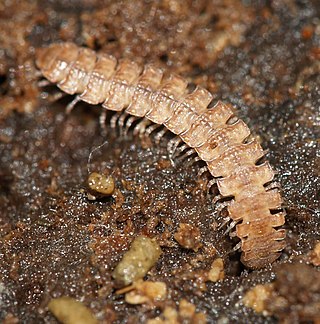
Chilognatha is a subclass of the class Diplopoda, which includes the vast majority of extant millipedes, about 12,000 species.
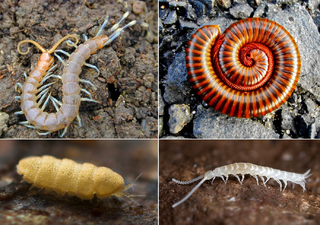
Myriapods are the members of subphylum Myriapoda, containing arthropods such as millipedes and centipedes. The group contains about 13,000 species, all of them terrestrial.

Pill millipedes are any members of two living orders of millipedes, often grouped together into a single superorder, Oniscomorpha. The name Oniscomorpha refers to the millipedes' resemblance to certain woodlice (Oniscidea), also called pillbugs or "roly-polies". However, millipedes and woodlice are not closely related ; rather, this is a case of convergent evolution.

Arthropleura is a genus of massive myriapod that lived in what is now Europe and North America around 345 to 290 million years ago, from the Viséan stage of the lower Carboniferous Period to the Sakmarian stage of the lower Permian Period. It is related to millipedes, and was capable of reaching at least 2 metres in length, possibly up to over 2.5 metres, making it the largest known land arthropod of all time. Arthropleura is known from body fossils as well as trace fossils, particularly giant trackways up to 50 centimetres (20 in) wide, and potentially also large burrows. It lived in open, sparsely wooded environments near water, and was possibly amphibious.
Euphoberia is an extinct genus of millipede from the Pennsylvanian epoch of the Late Carboniferous, measuring up to 15 centimetres (5.9 in) in length, that is small in Euphoberiidae which contains species with length about 30 centimetres (12 in). Fossils have been found in Europe and North America.
Eoarthropleura was a genus of millipede-like creatures which lived between the Late Silurian and Late Devonian periods. It reached 100 mm (3.9 in) in length. Fossils, mainly of cuticle fragments, have been found in Europe and North America. It is the earliest known member of the Arthropleuridea, and the oldest known terrestrial animal of North America.
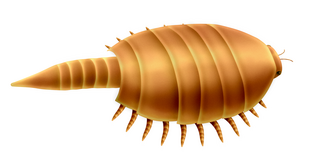
Euthycarcinoidea are an enigmatic group of extinct, possibly amphibious arthropods that ranged from Cambrian to Triassic times. Fossils are known from Europe, North America, Argentina, Australia, and Antarctica.
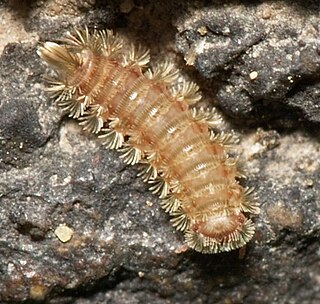
Polyxenida is an order of millipedes readily distinguished by a unique body plan consisting of a soft, non-calcified body ornamented with tufts of bristles. These features have inspired the common names bristly millipedes or pincushion millipedes. This order includes about 148 species in four families worldwide, which represent the only living members of the subclass Penicillata.

Archipolypoda is an extinct group of millipedes known from fossils in Europe and North America and containing the earliest known land animals. The Archipolypoda was erected by Scudder (1882) but redefined in 2005 with the description of several new species from Scotland. Distinguishing characteristics include relatively large eyes with densely packed ocelli, and modified leg pairs on the 8th body ring. Some species had prominent spines while others had a flattened appearance.
The Panther Mountain Formation is a geologic formation in New York. It preserves fossils dating back to the Devonian period. It is located in the counties of Albany, Madison, Oneida, Otsego, and Schoharie. It is well known for its fossil arthropods preserved as flattened cuticles, including Attercopus and Dracochela.
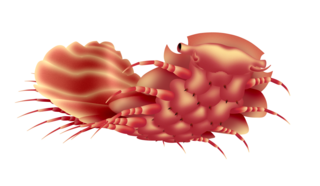
Microdecemplex rolfei is the only known species of the extinct, small-bodied millipede order Microdecemplicida. This order is originally considered as a member of the extinct subclass Arthropleuridea, but study in 2024 suggested to reject from the group, instead belongs to subclass Chilognatha. Fossils, measuring less than 5 mm in length, are known from the Panther Mountain Formation of New York State, dating to the Middle Devonian. This species apparently lacks antennae and shows sexual dimorphism in its hind legs, which may be similar in function to the telopods of male living pill-millipedes that are used to grasp females during mating.

Euphoberiidae is an extinct family of archipolypodan millipedes known from the Upper Pennsylvanian of Europe and North America. The family includes relatively large millipedes measuring up to 30 cm (12 in) long bearing distinctive spines and were the dominant millipedes of the Pennsylvanian.
Cowiedesmus is an extinct millipede genus described from Scotland, and is considered as earliest known land animals alongside Pneumodesmus from same formation. It is originally considered that it is from the middle Silurian, a 2017 study suggested that the geological formation it contains actually appears to be from the Early Devonian (Lochkovian) instead. Although a 2023 study confirmed the age identification of the 2004 study through palynological, palaeobotanical and ziron analyses incorporating newly discovered additional data, this is based on adjacent structurally separated block with different stratigraphy and sedimentology to the block with fossil site it was discovered, and it is confirmed as unsustainable. Cowiedesmus was about 4 cm (1.6 in) long and characterized by a greatly enlarged pair of legs on the 8th segment which may have been used in clasping females or functioned as gonopods. Coweiedesmus is distinct enough from other living and fossil millipedes to be placed in its own order, Cowiedesmida. The only known species, C. eroticopodus, was described in 2004.

Juliformia is a taxonomic superorder of millipedes containing three living orders: Julida, Spirobolida, and Spirostreptida, and the extinct group Xyloiuloidea known only from fossils.
William Albert Shear is Trinkle Professor Emeritus at Hampden-Sydney College, Virginia. He is a spider and myriapod expert who has published more than 200 scientific articles primarily on harvestman and millipede taxonomy.

Necrogammarus salweyi is the binomial name applied to an arthropod fossil discovered in Herefordshire, England. The fossil represents a fragmentary section of the underside and an appendage of a pterygotid eurypterid, a group of large and predatory aquatic arthropods that lived from the late Silurian to the late Devonian. The Necrogammarus fossil is Late Silurian in age and its generic name means "dead lobster", deriving from Ancient Greek νεκρός and Latin gammarus ("lobster").
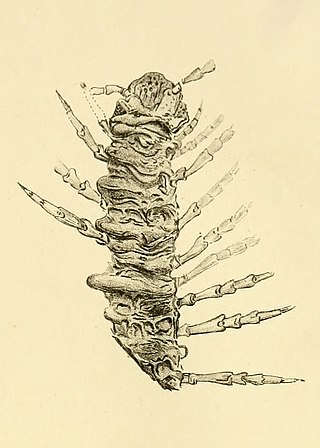
Kampecaris is an extinct genus comprising the Kampecarida, an enigmatic group of millipede-like arthropods, from the Silurian and early Devonian periods of Scotland and England. They are among the oldest known land-dwelling animals. They were small, short-bodied animals with three recognizable sections: an oval head divided along the midline, ten limb-bearing segments forming a cylindrical trunk that tapered slightly towards the front, and a characteristic swollen tail formed by a modified segment that tapers at its rear into an "anal segment". The cuticle forming their exoskeletons was thick, heavily calcified, and composed of two layers.
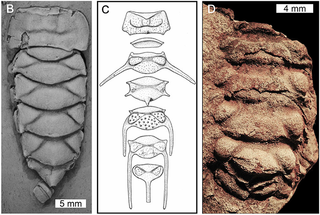
Maldybulakia is a genus of freshwater arthropod which lived during Late Silurian to Late Devonian. Maldybulakia is known from three species, M. angusi and M. malcolmi from Australia, M. mirabilis from Kazakhstan, and M. saierensis from China. Its classification is uncertain, it was originally described as a myriapod-like animal, and later considered related to the xiphosurans, or an artiopod.


















